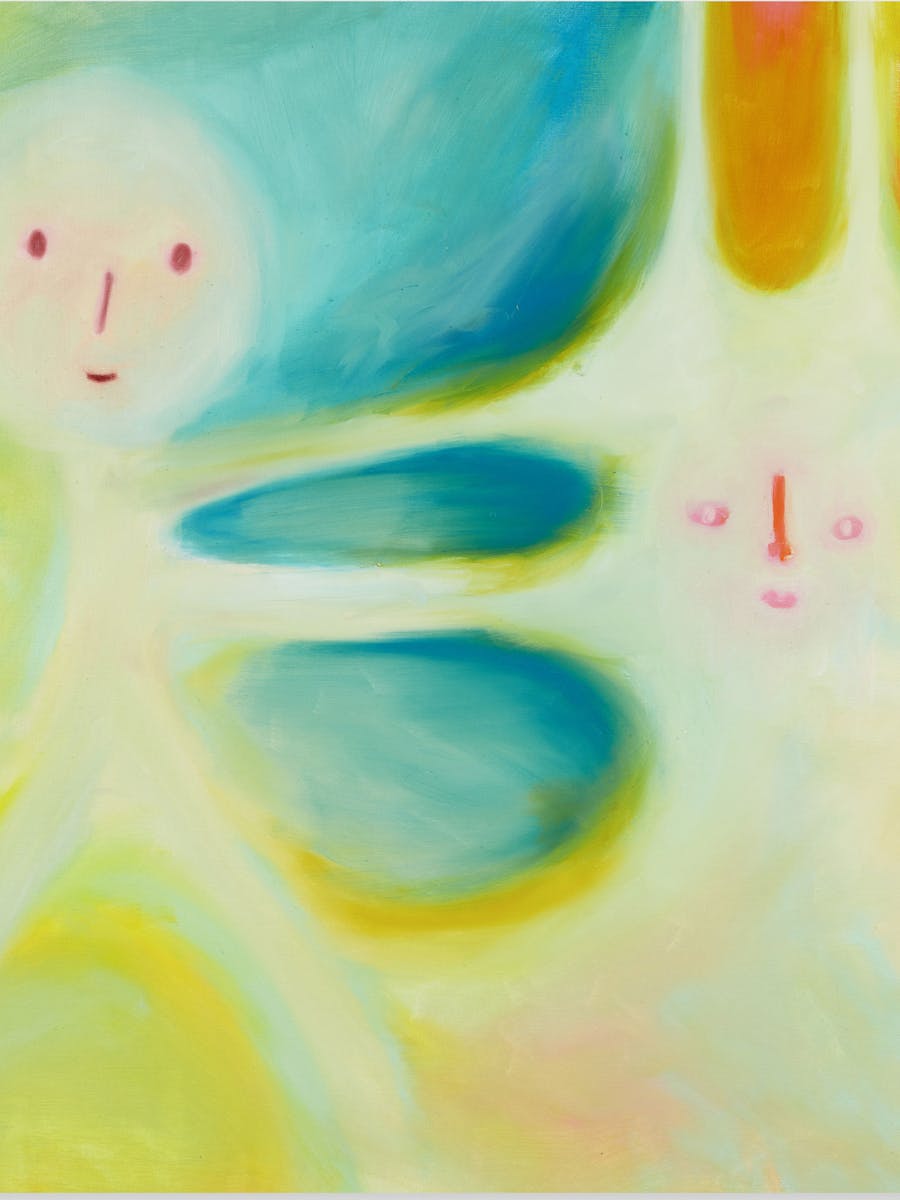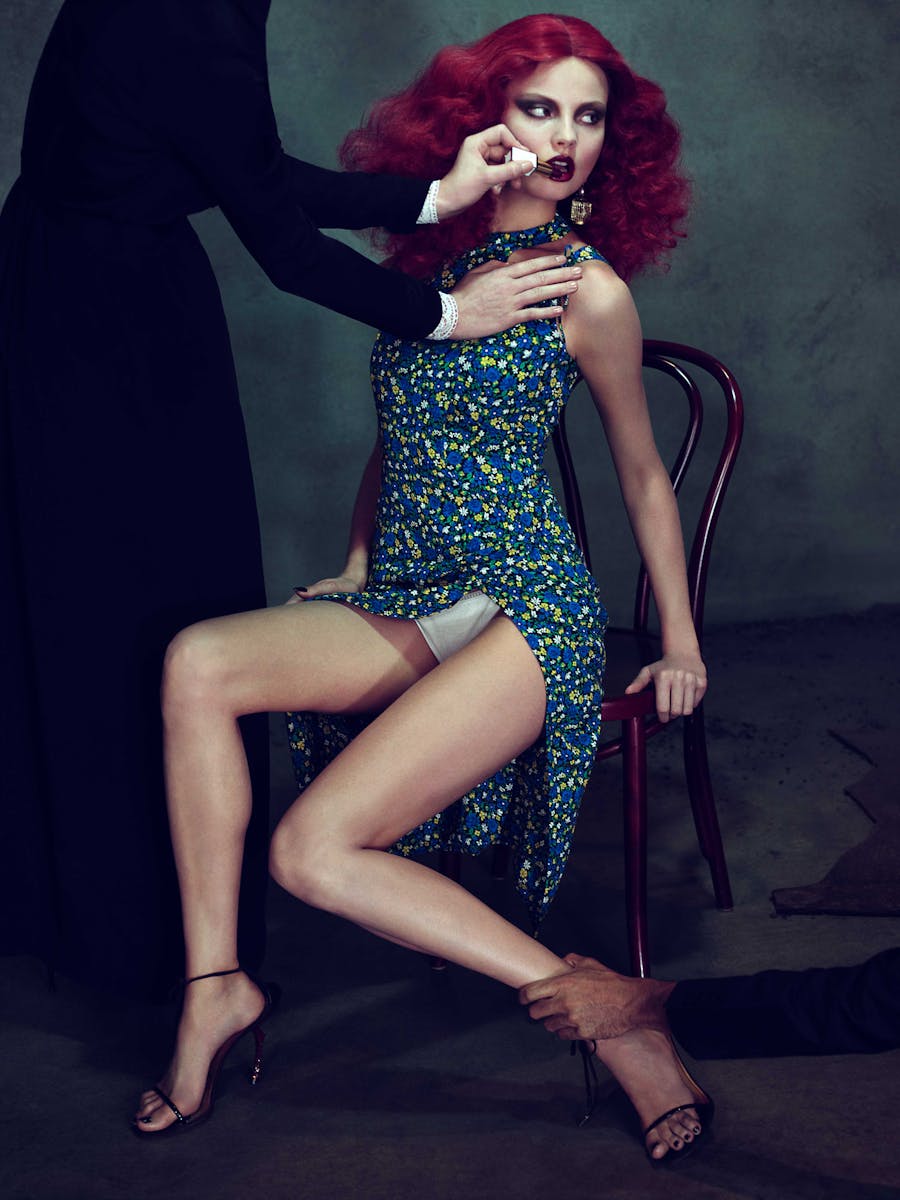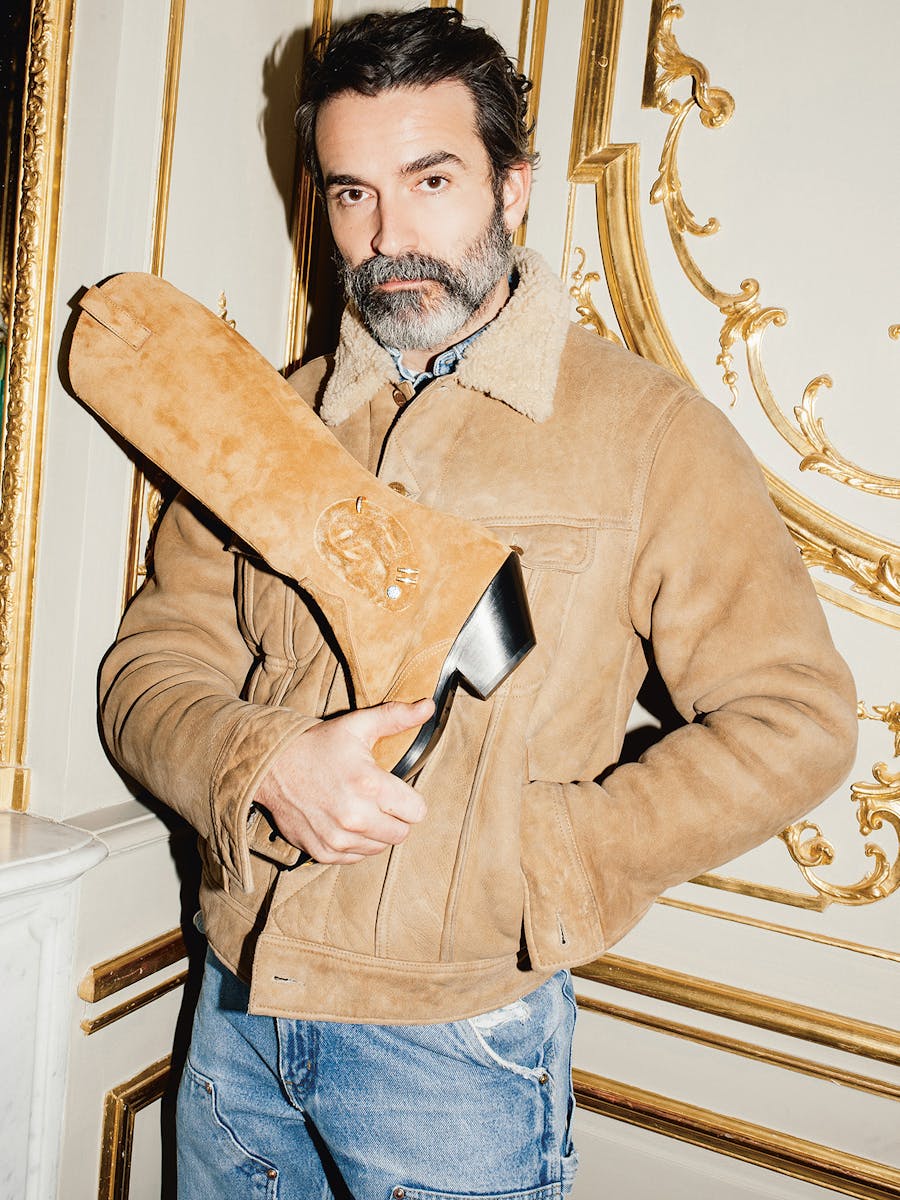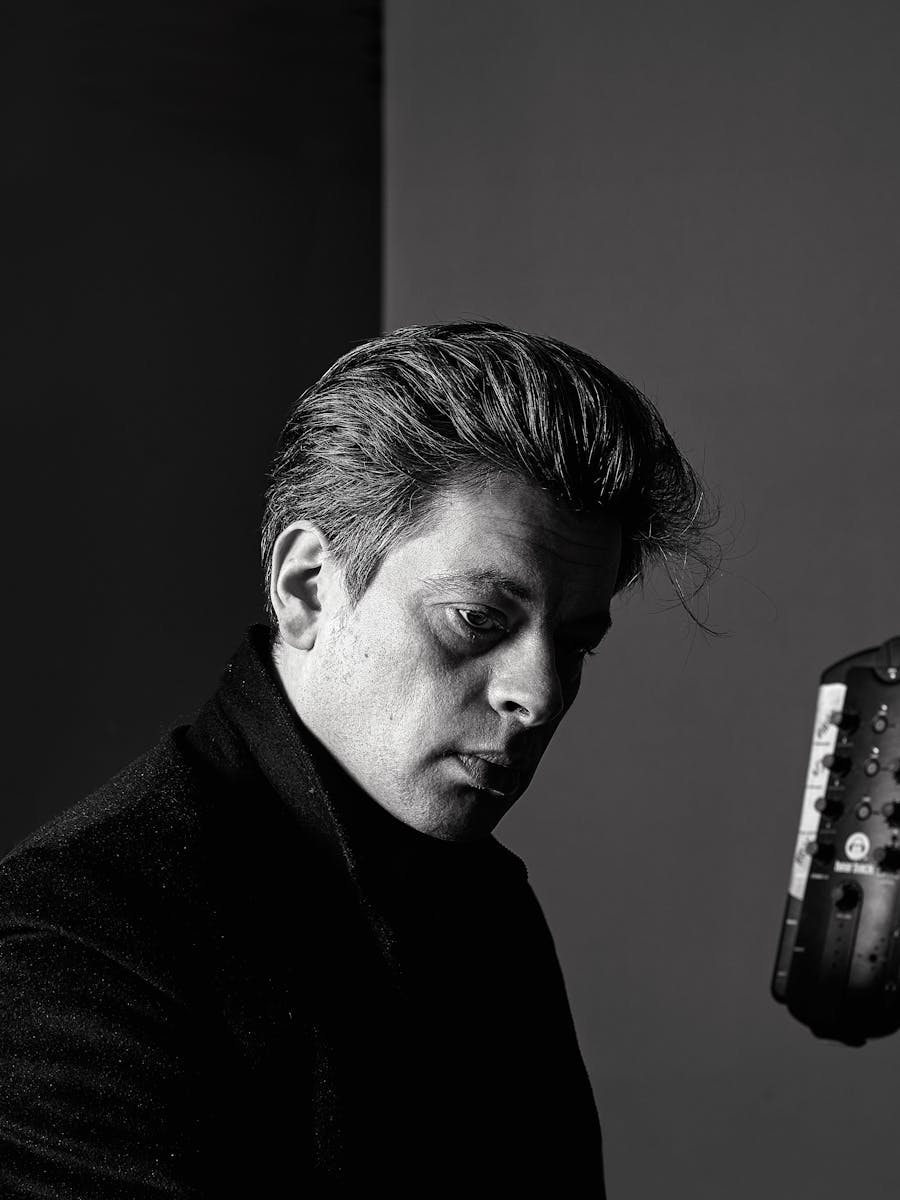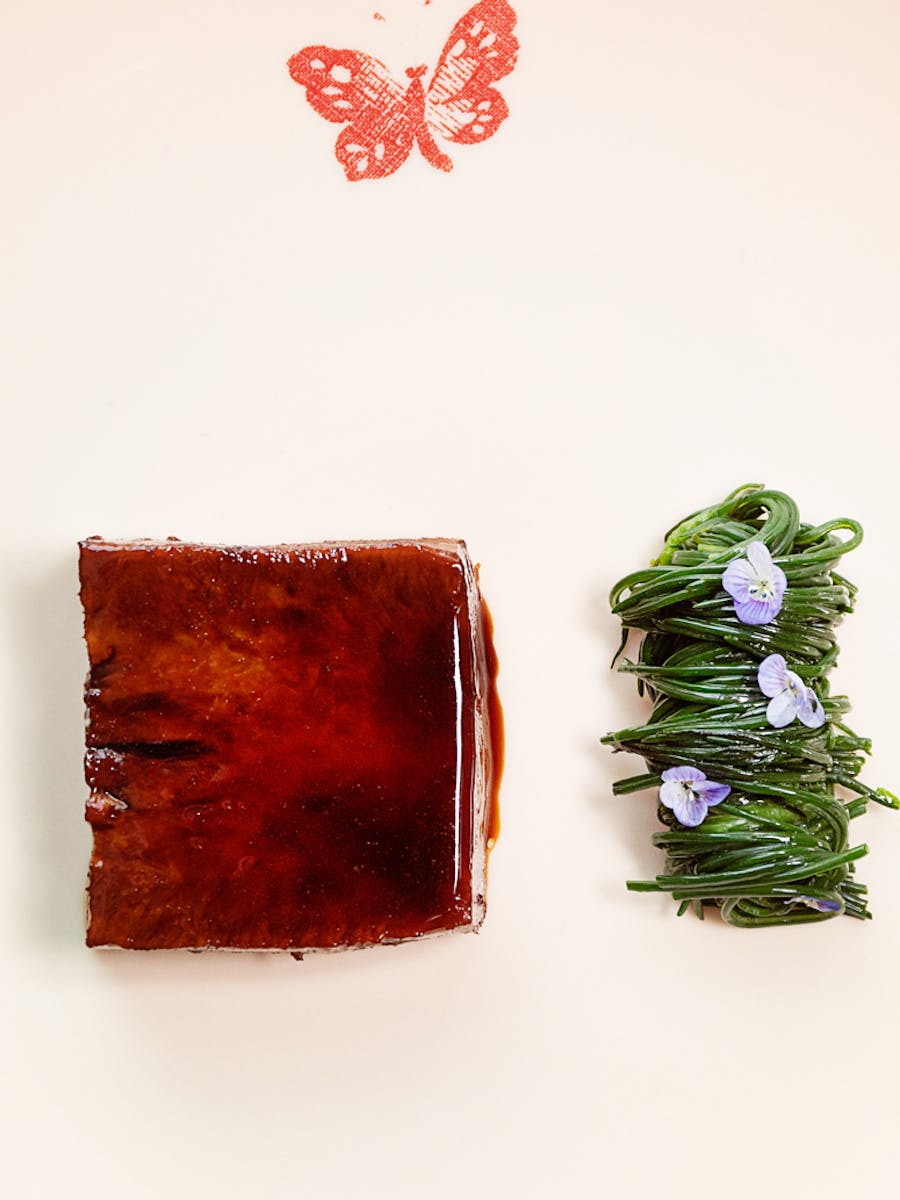Fashion is considered a visual art, but you can actually hear it. It’s in the music that makes you dance, the songs you can’t get out of your head, the sound that defines a generation. Senjan Jansen is the composer of choice for a coterie of Belgian fashion designers which includes Dries Van Noten, Haider Ackermann and Glenn Martens of Y/Project. A composer of film scores and atmospheres, he grew up in Turnhout, a small Belgian town on the Dutch border, where his mother designed theater costumes and worked on a large loom. But fashion was the last thing on his mind when he was plucked from his life as a New Beat DJ, to compose music for Haider Ackermann’s debut Paris show. Martens and Jansen have wanted to work together for years, ever since the Bruno Pieters shows set to Jansen’s music where Martens remembers that the sound made the audience cry.
Fashion is about partnerships, so tell me about yours.
SENJAN JANSEN (SJ) Even when we start early, it can end up in a rush.
GLENN MARTENS (GM) What happens usually is that I visit the show venue and film the situation. I take pictures and I send Senjan the whole set so that he already has an idea. Then I might give him more about the vibe of the collection.
Do you look at the clothes? Are there notes?
SJ ⏤ No, not really. I only see the clothes when I arrive in Paris just before the show. Normally we know what to do even before I see the clothes, but Glenn sends me moodboard pictures and if he already has some styling, he sends me that too.
How long have you worked together?
GM ⏤ We started when Y/Project was invited as Guest Designer at Pitti last January for the Men’s FW19 show in the cloisters of Florence’s Santa Maria Novella church. So we’ve worked together for a year on four shows. Senjan usually sits somewhere in a corner of the studio for a day to watch the styling. And then he does all the file editing here. So essentially he sees the whole thing.
SJ ⏤ That’s what I like to do most, sit in the atelier with Glenn and drink coffee where I can ask questions.
GM ⏤ Or he just looks.
SJ ⏤ Or I just do nothing...
Do people sometimes forget that you’re there?
SJ ⏤ Yes, all the time. I’m in my bubble with my headphones on listening to the tracks over and over and over again.
For Pitti you obviously went to Florence beforehand to look?
GM ⏤ No, he went to Florence the day before the show.
That must have been delicate.
SJ ⏤ Yes. The venue is extremely important. Sometimes it’s not the music, but how it sounds in the space. For the church at Pitti, the problem was the reverberation and how big the space is. Theoretically you could play any music in a cathedral, but it wouldn’t sound good.
Because of the acoustics?
SJ ⏤ Yes, the big space in the cloisters was quite hard to work with in the end. So I spaced out the sounds so there was time for reverberation.
GM ⏤ There were several difficulties at Pitti. It was our first collaboration, and it was in a church where you’re not allowed to use any sounds that aren’t abstract or religious. Secondly all the windows are from the 15th century and so we couldn’t use too much base.
SJ ⏤ There’s also the sound system. If you have a certain sound system, not all music will sound good on it. You can’t use a nice, full bass on a little sound system. It won’t work. So we have to pick and choose.
So you’re like a cook, spicing the composition?
GM ⏤ Y/Project is an independent brand so we’re obviously smaller than Senjan’s other clients. We can’t always get the biggest sound system.
You’ve been working together for a year now. How has that changed things?
GM ⏤ I think Senjan is starting to influence how I design. We talk before the show when I’ve already drawn the clothes, but I haven’t styled them yet, so the end result can look very different. With Y/Project of course you have all this quirkiness and opulence, but one season can be more dramatic, and the next more street. Now, for a month before the show I have his music in my head and it makes it easier. Everything begins to make more sense.
Glenn, you’re working with your own ideas for your own brand while Senjan starts with a brief. What would it be like if you switched places?
GM ⏤ Y/Project is a very specific brand because it has a heritage. We had like five stores when I arrived, but I was careful because we never had an investor and we needed those stores, also out of respect for Yohan (Yohan Serfaty, Y/Project’s original designer who passed away). Today everything has changed. This brand is completely a reflection of what I want to do with it. I want to have fun, explore all these extremes and different levels of fashion and human kind. There’s no point for me to redo this again for another brand. If I would work on another brand, it would have to have a strong and very different creative identity than Y/Project.
SJ ⏤ Every project I work on comes with ideas. And they all come from a different emotional world. If I had to choose all the music it would be very boring and stressful. I’ve made one record, it’s a dance track. But for the rest I’ve always worked for something, like for a fashion show, or a theater piece, or a television show. For me, it has more to do with people. I met Glenn before I worked with him. I liked the clothes so much that I wanted to work with him. But it doesn’t have to be like that. Sometimes you just don’t know what it’s going to be like and working together gives you something.
GM ⏤ Obviously Y/Project is not the only show Senjan is doing during Fashion Week. It gets frantic for him going from one soundtrack to the other.
SJ ⏤ Well you just have to learn to shut things up, turn things on and not react to the stress of all of it because each designer must have a perfect show. I can’t do more than five and I literally fall down after Fashion Week. Everything turns black.
So Senjan, with when it comes to composing, are you always taking things apart, or putting unrelated things together?
SJ ⏤ I never just play tracks. I don’t like that. We can use one track like Bobby Brown’s “My prerogative” for Y/project’s FW 2019 Women’s show, but then we do things with it. We stretch it, and we make something funny out of it. Usually Glenn has a very good idea to start with and then I work it out.
GM ⏤ And you can build the track, make it go much further.
SJ ⏤ I find the best quality version to start with. If it’s Bobby Brown I find the original record, the vinyl. Then I record it in high quality on my computer and start to edit it. And for specific sounds in those tracks, I have a huge collection of old synthesizers and drum machines. I can recognize if a sound is from the 80s or 90s. If Bobby Brown uses a half clap, then I think: ’okay that’s this drum machine, so I take it out, replay the sound and record it. You can’t feel the energy if you use MP3.
What kind of music are you listening to?
GM ⏤ It’s very dry at the moment. But I think that’s one of the reasons Senjan and I get along so well. There’s a lot of different eclectic vibes on my iTunes, but he has a much broader range of music and sounds than I do. So there’s never an issue when we talk together. If I talk about music from different eras, he knows what we’re talking about. Mostly I don’t know what he’s talking about, but he always knows what I’m talking about. The idea is to create something that’s as eclectic as the brand is. We can start with a sound that’s more retro and then he will completely fuck it up, turn it over and make it feel completely contemporary. He reinforces the eclecticism of that retro undertone so it’s not just a cliché of an old piece of music. I think that’s basically what the brand is all about.
For the Women’s SS20 show in the old club underneath the Pont Alexandre III, how did you two come up with that twisted version of Johann Strauss’ “The Blue Danube” Waltz?
GM ⏤ Well actually I think that was my idea. But the thing for me is that when I think of something, I really don’t have a clue if it’s possible or not. I’m thinking like: ’oh this could be cute.’ And then he’s the one who suffers.
Do you suffer Senjan?
SJ ⏤ Yeah I always suffer, but I also like to do things that I don’t think are possible. I want to take it to the limit. For me, any idea can be a good. I hardly ever say no. After that it can go fast, but in the end it usually takes days, hours and months.
This one was really extreme.
GM ⏤ Yeah, we really were quite stressed about it.
SJ ⏤ Not me and not Glenn really, but everyone else was.
GM ⏤ Well, I think I came up to Senjan about 10 minutes before the show and said: ’I just don’t think this is going to be possible.’
I’m always so surprised about what goes on backstage.
SJ ⏤ What’s so good about Glenn is that he goes for it. There are designers who when the boss, or somebody else, comes around and says: ’oh this is impossible,’ or ’I can’t stand it,’ will just shut it down. But the two of us always feel it’s going to be kind of great.
GM ⏤ But first there’s this really bad moment when we’re like: ’this is either going to be really annoying or...disastrous’. The point is, I don’t want to work with an artist like Senjan just so he can make a cute little background soundtrack that I could get from a DJ. I want to create a piece d’oeuvre. It should be an experiment and ideally a happening.
SJ ⏤ An experience.
How long was the SS20 women’s show?
SJ ⏤ About 10 minutes.
Okay, so it was 10 minutes of unadulterated fun, like Fred Astaire and Ginger Rogers dancing together. The music went so perfectly with the clothes.
GM ⏤ Yeah, that was the whole idea behind the Blue Danube Waltz, because the show was under the Alexander III bridge which was, of course, constructed during the hedonistic heyday of Paris’ ’la belle époque’ era, so obviously the waltz had to be in the air. Senjan made something completely twisted and a bit surreal out of it - la belle époque on acid!
Senjan, tell me about the Men’s SS20 show when you had Maria Callas and Beaker from the Muppets perform a duet of Georges Bizet’s “L’Amour est un Oiseau Rebelle” from the Carmen, the opera.
SJ ⏤ Glenn came up with the idea of Sesame Street which is very funny, but also an idea that could go extremely wrong. So my work was to make it believable.
GM ⏤ That’s the thing. We’re dealing with beauty and luxury. We can’t make a joke out of it. But as Y/Project is always about pushing extremes, and finding a little bit of a twist in everything, I think music can make fun when it’s done really, really well. Even though it’s Sesame Street, the combination with Callas elevated it into luxury.
SJ ⏤ The same goes for the clothes, it’s a question of deconstruction.
Do you like to take things apart?
SJ ⏤ Yeah a lot. I use big tracks, but it often comes down to tiny edits of the smallest sounds.
Can you make changes at the last minute?
SJ ⏤ Unfortunately I can. I work on it and work on it, but it’s only at the last minute, on the night before that we know exactly how long the show will be. “The Blue Danube” was very difficult because of the way it slowed down and sped up. Any change could mean and the music would be one minute too short, or two minutes too long.
GM ⏤ Every single sound is like a mountain of notes on Senjan’s computer.
SJ ⏤ It can be hours and hours of work and it’s a bit like styling which is a process of constructing and deconstructing. Glenn and his team stay up all night long and so do I.
GM ⏤ With “The Blue Danube”, the first proposition was much more musical, and then it became super technical. We start with a general idea and then it changes at the last minute because looks don’t arrive, or something else happens. We’re making changes.
SJ ⏤ For the waltz, at first I stretched the whole piece, but it didn’t work well. So then we thought: ’why not just take the loop, the most well-known part?’ So we moved that around, stretched it, and found it was getting better and better.
So it’s trial and error?
SJ ⏤ It’s more like analysing deeper and deeper until we find the right thing.
GM ⏤ We’re trying to get to the essence. When Callas is shouting like crazy and Senjan prolongs her highest note, it’s almost uncomfortable to listen to, and then she ends up singing the Habanera with Beaker.
But Glenn, how long does it take you to perfect a sleeve or a pant leg?
GM ⏤ It’s similar. We also keep on redoing it, or not redoing it, but going deeper until we get rid of everything superfluously decorative.
You deconstruct until the work becomes invisible?
SJ ⏤ I do a lot of soundtracks for theater and film, but I also edit bird sounds and wind sounds for cinema. I create atmospheres. The point is, you don’t hear a sound unless it’s wrong. A sound, any sound, has to be just there. It can be very abstract, or very real, but when it’s good, the audience doesn’t hear it.
GM ⏤ Sometimes Ideconstruct just for the fun of it. These clothes aren’t here to fill the basic needs of survival. We’re selling dreams and emotions. We help people confront who they are, or how they want to be seen and it’s also a business. Of course I’m really focused on construction, how far I can go with clothes. But some of this is just pure expression. And there are times when it doesn’t even matter if it’s beautiful, or wearable, it’s just artisanal.
There’s a cardigan in your SS20 women’s collection that looks like it’s blowing in the wind. It’s brilliant, effortless, and it’s a complete deconstruction.
GM ⏤ Well that’s mostly a question of luck to be honest. We’re a small team and obviously we don’t have much time. We can’t produce this amazing piece in four different kinds of knit. The first one has to work, but I knew with the cardigan that if I took out the lining it would be great. Unfortunately it’s often a lot trickier than that. We can do a lot of work and then think: ’this isn't working’.
And how about Bobby Brown? That was such an unusual 80s choice for your FW19 Women’s show.
GM ⏤ I almost forgot about “My Prerogative.” Whitney’s in there too. There’s always an anecdote.
SJ ⏤ And Britney’s there as well: “(You Drive Me) Crazy”.
Whitney and Britney?
GM ⏤ Britney has a crazy moment and Whitney has a very dramatic interview. I think it all started with the iconic ’Crack is whack’ - the phrase that Whitney famously used to respond to interviewer Diane Sawyer when asked about about drugs. She was at a very low point in her life and Senjan took that and made a whole sound out of it. We were a bit mental that season. I was influenced by a documentary I’d seen about Whitney Houston the year before. In the end I was a bit stressed about the music because of the whole Whitney/Bobby issue.
They had been a bit abusive to each other and I didn’t want anyone to take the show’s music the wrong way. But it’s obvious they were also passionately in love and that can be complicated.
SJ ⏤ And you are a 90s kid Glenn.
GM ⏤ I am.
How would you describe yourself Senjan?
SJ ⏤ I’m more of an 80s kid. I skipped Bobby Brown and the 90s. I was completely into the electronic techno scene in the 90s, Belgium’s New Beat.
GM ⏤ You’re more digital.
SJ ⏤ Yeah I like new sounds. I like everything that’s new. It’s not like I don’t like violins. I love classical music, but I’m searching for new technology and new things to manipulate sounds and music. What makes me happy is taking something that exists and turning it over with all the tools I have to transform it into something beautiful again.
What did you go through musically when you were growing up Glenn?
GM ⏤ Actually I’m not the biggest music guy. I mean I love Bobby Brown and Whitney Houston... I think my upbringing was more traditional than Senjan’s.
SJ ⏤ I grew up listening to “Einstein on the Beach.” That was my dad’s favorite.
GM ⏤ It wasn’t so revolutionary when I was a teenager in a conventional little city like Bruges. I was going to bars where all they played popular music and the classics like the really random music you can find anywhere in the Flemish countryside. Until I was 18 I had maybe five CDs and one of them was The Cranberries, the other was The Red Hot Chili Peppers and the third was probably The Lion King.
Did music ever influence your clothes?
GM ⏤ Not really. My awakening was turning 18 and moving to Ghent, meeting the friends I still have now and studying architecture. I think I was a bit of a Trip Hop guy. My sound at university was Portishead and Massive Attack. I still listen to Portishead at least once a week. In Paris I listen to FIP radio. I think it’s amazing. It’s super eclectic. I hardly have the urge to buy music now because at home FIP is on from morning till night.
SJ ⏤ Since I work with sound all day, I never listen to music. Even in the car, it’s just silence.
So what are you thinking about in the car?
SJ ⏤ Structures and sounds, which instruments to use.
Do you ever get bored, and say: ’I can’t listen to that any more!’
SJ ⏤ Yeah, especially when the deconstruction process is becoming easier and easier. I’m like: ’okay, I’ve already heard this a million times. Once in a while something new pops up, but it’s rare.
GM ⏤ I think we all have the same problem. Everything is so easy to digest in music just as it is in fashion. Freedom isn’t the problem. It’s the sense of security that comes with following hype. Everyone wants to stay superficial, fast and safe. There’s nothing easier than wearing a logo.
SJ ⏤ But this is also a very interesting time because we’re getting closer to the edge.
GM ⏤ It’s true we’re reaching our limit. Y/Project is not so straightforward and easy. The reviews we’ve had in the past are funny: one would say we’re streetwear, another would say it’s couture and conceptual. In one show we’d be defined five different ways.
SJ ⏤ But the good things will always rise to the surface. It’s like everybody can write a note today, but where are the good books? Everybody can film with a camera, but where are the good films? It’s the same thing in music. Everybody makes music now. Real DJs are almost disappearing. Everybody plays their own music because it’s easy, but good music will still prevail.
Both of you are holdouts for what you want. So do you even have what you want?
GM ⏤ What even is success? Is it making buildings and logos? Being happy and creating things that you’re proud of? Perhaps you’re not making as many buildings as you’d like, but it’s exciting and you’re having fun. Everybody has their own definition of success and happiness. For certain designers it’s about making buildings or T-shirts, but for me it’s about being able to keep on doing fun things and experimenting while making sure that we actually grow and that people can earn money and live a happy life off of it.
SJ ⏤ For me it’s also important to have a life, knowing that I can do a lot of different, fun things and that I don’t need anything in particular.
